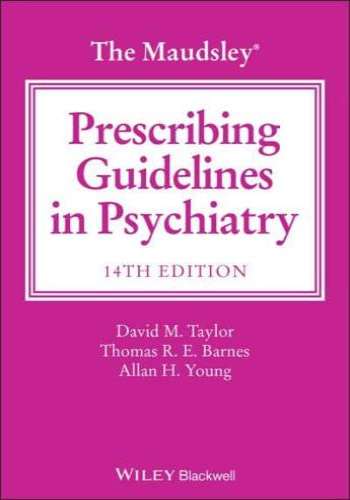The Maudsley Prescribing Guidelines in Psychiatry
The new edition of the world-renowned reference guide on the use of medications for patients presenting with mental health problems
The Maudsley Prescribing Guidelines in Psychiatry is the essential evidence-based handbook on the safe and effective prescribing of psychotropic agents. Covering both common and complex prescribing situations encountered in day-to-day clinical practice, this comprehensive resource provides expert guidance on drug choice, minimum and maximum doses, adverse effects, switching medications, prescribing for special patient groups, and more. Each clear and concise chapter includes an up-to-date reference list providing easy access to the evidence on which the guidance is based.
The fourteenth edition has been fully updated to incorporate the latest available research, the most recent psychotropic drug introductions, and all psychotropic drugs currently used in the UK, USA, Canada, Australia, New Zealand, and Japan. Several new sections cover topics such as deprescribing of major psychiatric drugs, prescribing psychotropics at the end of life, the treatment of agitated delirium, the genetics of clozapine prescribing, the use of weekly penfluridol, and the treatment of psychotropic withdrawal. Featuring contributions by an experienced team of psychiatrists and specialist pharmacists, the new edition of The Maudsley Prescribing Guidelines in Psychiatry:
- Provides succinct coverage of drug treatment of psychiatric conditions and formulating prescribing policy in mental health
- Covers a wide range of psychiatric conditions including schizophrenia, bipolar disorder, depression and anxiety, borderline personality, eating disorders, and many others
- Provides advice on prescribing for children and adolescents, older people, pregnant women, and other special patient groups
- Offers new sections on genetic prescribing, long-acting injectable formulations, ketamine administration and uses, and dopamine super-sensitivity
- Includes referenced information on off-label prescribing, potential interactions with other substances such as alcohol, tobacco, and caffeine, and treating patients with comorbid physical conditions
Whether in the doctor's office, in the clinic, or on the ward, The Maudsley Prescribing Guidelines in Psychiatry, Fourteenth Edition is a must-have for psychiatrists, pharmacists, neuropharmacologists, clinical psychologists, nurses, and other healthcare professionals working in mental health, as well as trainees and students in medicine, pharmacy, and nursing.







